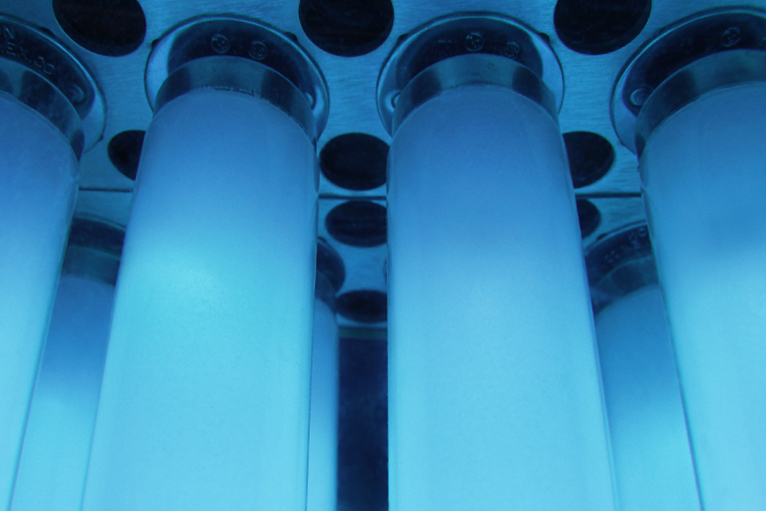It seems that every day brings a new Ultraviolet Germicidal Irradiation (UVGI) device that promises 99%+ efficiency on “killing” or neutralizing viruses. What does that efficiency level mean, and does it represent how effective it will be in all applications? These are all essential questions that we will attempt to explain in this blog.
What is Ultraviolet Germicidal Irradiation (UVGI)?
First, let’s explain what UVGI is in technical terms; Ultraviolet Germicidal Irradiation is electromagnetic radiation that can destroy the ability of microorganisms to reproduce by causing photochemical changes of the Pathogens DNA/RNA. Wavelengths in the UVC range are especially damaging to cells because nucleic acids, such as those found in DNA, absorb them. Got that?! In simple terms, the effect of the intensity of the light changes the structure of the pathogen rendering it unable to reproduce. Very intense light indeed.
It is also critically important that these bulbs operate at the 254 nm (nanometer) wavelength. These types of UV-C (C being the wavelength band) bulbs do not produce ozone. You do not want an accumulation of ozone that is harmful to breathing.
The effectiveness of Ultraviolet Germicidal Irradiation bulbs on neutralizing pathogens can be stated as the combination of the intensity level (wavelength of light) and exposure time. The longer the pathogen is exposed to the appropriate intensity, the higher percentage of pathogens are neutralized.
Case closed?! Not hardly, how effective the UVGI is in a given environment is subject to several factors, including occupancy (how many people are in a room, and the number and location of supply air and return units.) The result is not a percentage number but a Clean Air Delivery Rate (CADR) of a particular system, and the reduction in infection probability. No system can guarantee a percentage of a virus is neutralized. That would be misleading at best. If a supplier or manufacturer cannot provide you with the Clean Air Delivery Rate and the reduction in infection probability about their system in your application, keep looking.
How do you calculate Clean Air Delivery Rate (CADR)?
How does one calculate CADR (Clean Air Delivery Rate) and reduction in infection probability? Fortunately, there is an industry formula that any competent supplier or manufacturer has access to that can provide this information. It is called the Wells Riley Equation.

- Q = Clean/Uninfected Airflow
- t = Time
- p = # of People
- I = respiratory rate
Now don’t despair; there are plenty of people a lot smarter than this author that can run these calculations. What is essential to understand is what the resulting information provides us with.
- Must be calculated to determine UVGI solution effectiveness
- Used to calculate infection probabilities in an occupied space
- Probability decreases as exposure time (t) decreases and/or clean airflow (Q) increases
- Infection probabilities for different disinfection solutions can then be compared
- Wells Riley only accounts for airborne infections – infections from close contact can be mitigated with masks, social distancing, and cleaning
That last bullet point is an important consideration. A Ultraviolet Germicidal Irradiation (UVGI) device is used in conjunction with established mitigation protocols such as social distancing, wearing face masks, and increased sanitizing (handwashing, disinfecting.)
When calculating the effectiveness of a system, the essential variables are outside clean air available, time, number of people, and respiratory rate (seated, active?)

For example, if you had 32 people in a room sitting down, such as a lecture hall or restaurant, and you installed a mobile Ultraviolet Germicidal Irradiation (UVGI) device capable of moving 1200 cfm, what could you expect the result to be? Assuming a known intensity level for the bulbs, the current outside air requirement would be 480 cfm (15cfm per person x 32). Adding 1200 cfm of clean air (cleaned by the UVGI device), you are now delivering the equivalent of 1680 cfm of disinfected air (480cfm +1200 cfm), which will reduce the probability of airborne infection by 3.3 times (Remember Wells-Riley?) If you add an additional unit or reduce the number of people, the likelihood of infection would be reduced further. Conversely, if you increased the occupancy without adding additional UVGI, then you would the probability number would be lower than 3.3.
The more clean air that is available, whether by natural means, bringing in outdoor air through the ventilation system, or adding Ultraviolet Germicidal Irradiation to complement existing outside air available, the probability of infection would decrease.
Finally, the location of the installation of these devices is also vital to maximize their effectiveness. Consult with experts in ventilation that understand airflow and how it moves through a space.
Published by:
Rich Catan
Director of Marketing and Segment Development, Halton Company
Follow Rich Catan on LinkedIn
Our recommended next article would be: What are the best practices for ventilation system for restaurants and food service facilities re-opening after the pandemic?
Leave us a comment below, and we will answer, or if you have any questions, please send us a message here
Subscribe to kitchenventilation.com
Stay up to date by subscribing to Halton’s Commercial Kitchen Ventilation Blogs by entering your email address to subscribe. Halton will provide you with the latest information on commercial kitchen exhaust hoods and systems, pollution control units, air handling, and safety systems. You will receive notifications of new posts by email.


Comments
2 responses to “How effective is Ultraviolet Germicidal Irradiation (UVGI) lights in neutralizing a virus?”
[…] air filtration units typically come complete with high-capacity UVGI and MERV filters and can be used safely in any indoor space where there is a risk of virus spread. […]
[…] Read another article relating to UVGI How effective is Ultraviolet Germicidal Irradiation (UVGI) lights in neutralizing a virus?(Opens in … […]